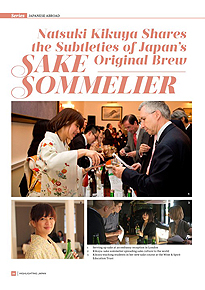Home > Highlighting JAPAN >Highlighting Japan August 2014>Japanese Abroad
Highlighting JAPAN

Japanese Abroad
Sake Sommelier
Natsuki Kikuya Shares the Subtleties of Japan’s Original Brew

Natsuki Kikuya, head of the London-based Museum of Sake, an organization that provides education and promotion for the craft of sake, is a sake sommelier. Customers at upscale restaurants have long been able to consult a sommelier about wine and food pairings, and they now enjoy a new option as Kikuya and other sake sommeliers take the beverage beyond the boundaries of Japanese cuisine.
Kikuya’s choice of occupation and deep knowledge of sake seems entirely fitting for someone from a family-owned sake brewery in Akita Prefecture with over three and a half centuries of history. Kikuya, however, says that being a sake sommelier was the furthest thing from her mind. After completing college in the US and returning to Japan to work, she still did not have a great enthusiasm for sake. While working at a Tokyo-based human resource consulting firm, she rethought her career after her grandfather’s health suddenly declined.
Kikuya’s initial reaction was that she wanted to give something back to her family by doing something related to sake. She left her job and began delving into the world of sake by working at Hasegawa Saketen, a specialty sake retailer in Tokyo. The experience was invaluable because it gave her the opportunity to try different brews from all over Japan, all the while learning and taking notes from her passionate coworkers. “I soon fell in love with the whole world of sake,” Kikuya says.
After being certified as a sake sommelier, Kikuya decided to head to the UK, where sake was not nearly as established as in the US. She began working for Zuma, a well-known Japanese restaurant in London. Several years later, she became head sake sommelier at another such establishment called ROKA. Sake sales doubled in her first year there.
Kikuya wished to share her love of sake throughout London on a bigger scale. In 2013 she launched the Museum of Sake. Using sake, she connects Japan to the UK and Europe through a range of special events and courses for the wider public and food industry. Although it is only a virtual museum at the moment, Kikuya says she dreams of someday opening a physical location that features the history, people and food culture of sake.
One of Kikuya’s primary objectives is to show sake’s versatility. While it is already a well-known accompaniment to Japanese cuisine such as sushi, Kikuya is convinced that matching sake with non-Japanese dishes can work equally well. Indeed, Museum of Sake events—such as those pairing sake with Indian food or even white truffles—have sold out quickly.
Kikuya has found that people in the UK and elsewhere in Europe are particularly interested in the story behind the beverage. “They want to know about the history, the techniques, the regions, and by learning about all those factors, they gain reassurance about the quality,” she observes. Kikuya believes this emphasis on the total story stems from Europe’s deep-rooted wine culture.
Gradually the interest toward sake has spread to the wine industry. The International Wine Challenge (IWC) has featured a sake category since 2007, and Kikuya won the IWC Sake Communicator Award in 2011. She is also now one of the judges for the sake category. In addition, Kikuya is the instructor for a Japanese sake course that she established in August 2014 at the Wine & Spirit Education Trust (WSET), a wine educational institution that has partnerships with over sixty-two countries around the world.
Although her efforts to impart the history and complexity of sake are just beginning, Kikuya is ready for the challenge. “Sake is just as rich and complex as wine,” she says. “There’s a whole world, a whole culture behind a bottle of sake.” Sake’s surge in popularity abroad is sure to lead to a deeper understanding of Japan's rich culture.
© 2009 Cabinet Office, Government of Japan






